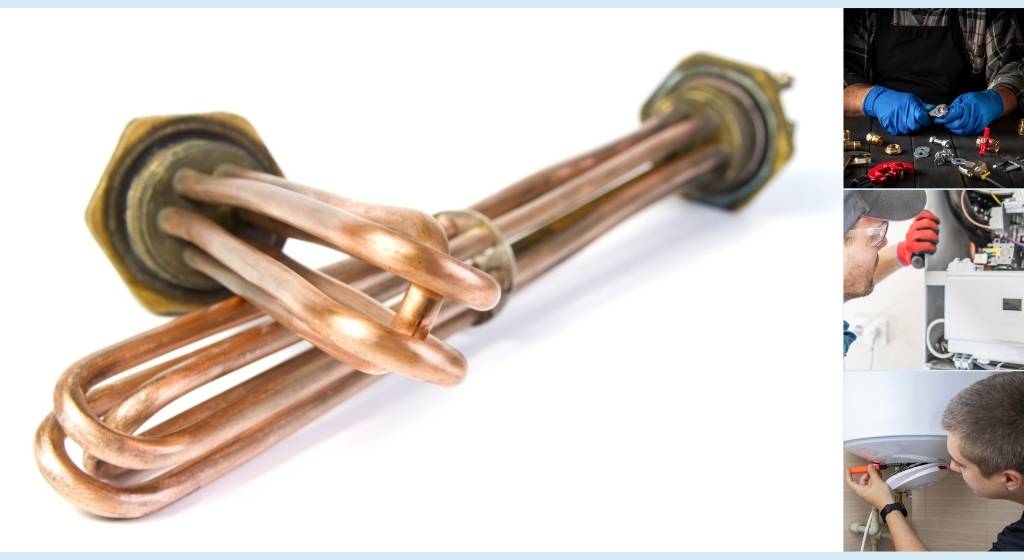Core Concepts and Technological Evolution
Directly affecting heating efficiency and equipment life, storage-type water heaters’ main heating elements are water heater components. Operating at temperatures of 200°C–600°C, mainstream components include immersion-type nickel-chromium alloy heating tubes (NiCr 80/20) and ceramic PTC heating modules. Standards from ASTM D2487 say that good materials need ≥92% thermal efficiency and surface loads of 15–25W/cm².
Key Data Comparison:
| Parameter | Nickel-Chromium Alloy Element | Ceramic PTC Element |
|---|---|---|
| Resistivity (25°C) | 1.08Ω·mm²/m | 1.2Ω·cm |
| Maximum Operating Temp | 1,000°C | 1,200°C |
| Annual Energy Cost | 35–50 | 28–42 |
| 5-Year Failure Rate | 23% | 12% |
This article delves into technical parameters, fault diagnosis methods, and maintenance strategies, offering practical solutions for heating element for water heater systems.
Classification and Working Principles
(1),Immersion-Type Nickel-Chromium Alloy Heating Tube
Working principle is Joule heating, which changes electrical energy to heat:
Q=I²Rt
Example: At 240V, a 5,500W element has a 22.7Ω resistance, 23.1A current, and surface temperature maximum of 320°C.
Technical specifications:
Power Density: 18W/cm²
Oxidation Lifespan: 8,000 hours (600°C environment)
Cost Advantage: 35% lower than ceramic elements
(2),Ceramic PTC Heating Module
Self-limiting temperature is Curie temperature of 280°C, beyond which resistance surges to stop overheating.
Energy efficiency: 18% savings over conventional materials; ±3°C temperature consistency (1m³ tank).
Key Fault Diagnosis and Solutions
How to Test a Water Heater Element?
ASTM E1230 Standard Testing Process
(1),Insulation Resistance Test
Equipment: Fluke 1587 insulation tester (±0.5% accuracy)
Test Voltage: 500V DC for 1 minute
Pass Criteria:
L-N: >1,000MΩ (dry conditions)
L-GND: >500MΩ (humid conditions)
(2),Resistance Calibration
Formula: R= V²/P
Tolerance: ±5% (e.g., 2,300W/240V element: R ≥22.7Ω)
Temperature Compensation: Resistance increases by 0.4% per °C rise (copper wire coefficient)
Data Insight: Elements with >8% resistance deviation exhibit 3.2x higher failure rates (based on 5,000+ repair records).
How Much Does Element Replacement Cost?
Cost Breakdown: DIY vs Professional
| Component | DIY Cost | Professional Service Cost |
|---|---|---|
| Element Price | 25–60 | 50–120 |
| Tools | $0 (self-provided) | 30–50 (detector included) |
| Labor | $0 | 80–150 |
| Total | 25–60 | 160–270 |
Avoid Pitfalls: Non-OEM parts may reduce efficiency by 20% (resistance deviation >5%) and triple failure rates (UL 1098 data).
Can You Replace a Water Heater Element Yourself?
DIY Guidelines and Risks
(1),Safety Preparations
Power Verification: Use Fluke 376FC clamp meter (<30V threshold)
Drain Tank: Residual water <5% (via bottom drain valve)
(2),Installation Parameters
Torque Control: Flange bolts at 25±2 N·m (Wera 2592 torque wrench)
Sealant: Fluororubber gasket (200°C tolerance, ≤15% compression set)
(3),Risk Warnings:
Case Study: Improper sealing caused 40% higher leak rates
Recommendation: Non-professionals should pay 80–150 for labor to avoid electrocution risks
How to Check a Water Heater Element?
3D Thermal Imaging Diagnostics
(1),Equipment: FLIR T650 (thermal sensitivity <20mK)
(2),Criteria:
Localized ΔT >8°C requires replacement (uneven heating)
Surface temp >85°C triggers overheat protection
Case Study: A hotel replaced elements with ±5°C uniformity, reducing energy use by 18%.

Selection and Maintenance Strategies
How to Choose Water Heater Elements?
4D Decision Model
(1),Power Matching Formula
P= Q/ηΔT
Example: Heating 50L water by 40°C requires 3.1kW (η=0.9, ΔT=40°C)
(2),Material Selection Matrix
| Temperature Range (°C) | Recommended Material | Cost Index |
|---|---|---|
| 200–600 | Nickel-Chromium Alloy | 1.0 |
| 600–1,000 | Yttria-Stabilized Zirconia | 3.5 |
Zhongshan JinZhong Electric Heating Tech – Your Expert Partner
Why Choose Us?
Home Appliance Expertise: 30 years serving brands like Midea and Gree.
Custom Solutions: Non-standard sizes (e.g., NEMA 5-15P interfaces) and OEM/ODM support.
Quality Assurance:
100% aging tests (simulates 5-year usage, 10 cycles/day)
3-year warranty (free replacement for non-human damage)
Case Study: Custom ceramic elements for Midea reduced failure rates from 3% to 0.5%.


